
Atari ST is a line of personal computers from Atari Corporation and the successor to the company's 8-bit home computers. The initial model, the Atari 520ST, had limited release in April–June 1985, and was widely available in July. It was the first personal computer with a bitmapped color graphical user interface, using a version of Digital Research's GEM interface / operating system from February 1985. The Atari 1040ST, released in 1986 with 1 MB of memory, was the first home computer with a cost per kilobyte of RAM under US$1/KB.

The Original Chip Set (OCS) is a chipset used in the earliest Commodore Amiga computers and defined the Amiga's graphics and sound capabilities. It was succeeded by the slightly improved Enhanced Chip Set (ECS) and the greatly improved Advanced Graphics Architecture (AGA).

The Apple IIe Card is a compatibility card, which through hardware and software emulation, allows certain Macintosh computers to run software designed for the Apple II. Released in March 1991 for use with the LC family, Apple targeted the card at its widely dominated educational market to ease the transition from Apple II-based classrooms, with thousands of entrenched educational software titles, to Macintosh-based classrooms.

The Macintosh Plus computer is the third model in the Macintosh line, introduced on January 16, 1986, two years after the original Macintosh and a little more than a year after the Macintosh 512K, with a price tag of US$2,599. As an evolutionary improvement over the 512K, it shipped with 1 MB of RAM standard, expandable to 4 MB, and an external SCSI peripheral bus, among smaller improvements. Originally, the computer's case was the same beige color as the original Macintosh, Pantone 453; however, in 1987, the case color was changed to the long-lived, warm gray "Platinum" color. It is the earliest Macintosh model able to run System Software 5, System 6, and System 7, up to System 7.5.5, but not System 7.5.2.
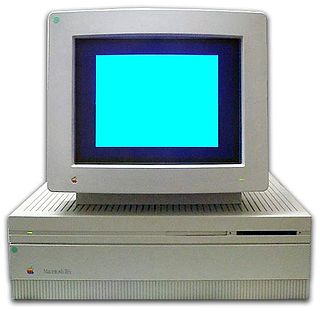
The Macintosh IIfx is a personal computer designed, manufactured and sold by Apple Computer from March 1990 to April 1992. At introduction it cost from US$9,000 to US$12,000, depending on configuration, and it was the fastest Macintosh available at the time.
GeoPort is a serial data system used on some models of the Apple Macintosh that could be externally clocked to run at a 2 megabit per second data rate. GeoPort slightly modified the existing Mac serial port pins to allow the computer's internal DSP hardware or software to send data that, when passed to a digital-to-analog converter, emulated various devices such as modems and fax machines. GeoPort could be found on late-model 68K-based machines as well as many pre-USB Power Macintosh models and PiPPiN. Some later Macintosh models also included an internal GeoPort via an internal connector on the Communications Slot. Apple GeoPort technology is now obsolete, and modem support is typically offered through USB.
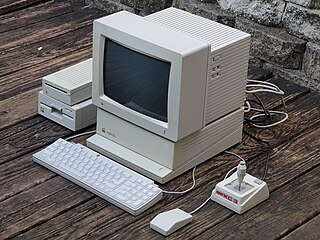
The Apple IIGS is a 16-bit personal computer produced by Apple Computer beginning in September 1986. It is the fifth and most powerful model of the Apple II family. The "GS" in the name stands for "Graphics and Sound", referring to its enhanced multimedia hardware, especially the state-of-the-art audio. It is compatible with earlier Apple II models, and Apple initially sold a kit for converting an Apple IIe into a IIGS. The system is a radical departure otherwise, with a WDC 65C816 microprocessor, initially 256 KB of random-access memory expandable to 8 MB, resolution and color similar to the Amiga and Atari ST, and a 32 channel Ensoniq wavetable synthesis chip. Bundled with a mouse, it is the first computer from Apple with a color graphical user interface and the Apple Desktop Bus interface for keyboards, mice, and other input devices.

The Apple IIc is a personal computer introduced by Apple Inc. shortly after the launch of the original Macintosh in 1984. It is essentially a compact and portable version of the Apple IIe. The IIc has a built-in floppy disk drive and a keyboard, and was often sold with its matching monitor. The c in the name stands for compact, referring to the fact it is a complete Apple II setup in a smaller notebook-sized housing. It is compatible with a wide range of Apple II software and peripherals.

The Macintosh 512Kenhanced (512Ke) was introduced in April 1986 as a cheaper alternative to the top-of-the-line Macintosh Plus, which had debuted three months previously. It is the same as the Macintosh 512K but with the 800K disk drive and 128K of ROM used in the Macintosh Plus. Like its predecessors, it has little room for expansion. Some companies did create memory upgrades that brought the machine up to 2 MB or more.

The Macintosh, later rebranded as the Macintosh 128K, is the original Macintosh personal computer from Apple. It is the first successful mass-market all-in-one desktop personal computer with a graphical user interface, built-in screen and mouse. It was pivotal in establishing desktop publishing as a general office function. The motherboard, a 9 in (23 cm) CRT monochrome monitor, and a floppy drive are in a beige case with integrated carrying handle; it has a keyboard and single-button mouse.

The Macintosh 512K is a personal computer that was designed, manufactured and sold by Apple Computer from September 1984 to April 1986. It is the first update to the original Macintosh 128K. It was virtually identical to the previous Macintosh, differing primarily in the amount of built-in random-access memory. The increased memory turned the Macintosh into a more business-capable computer and gained the ability to run more software. It is the earliest Macintosh model that can be used as an AppleShare server and, with a bridge Mac, communicate with modern devices.
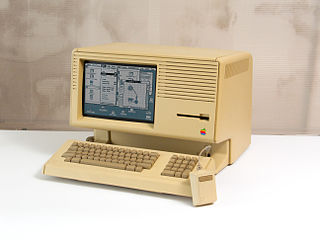
Macintosh XL is a modified version of the Apple Lisa personal computer made by Apple Computer. In the Macintosh XL configuration, the computer shipped with MacWorks XL, a Lisa program that allowed 64 K Macintosh ROM emulation. An identical machine was previously sold as Lisa 2/10 with the Lisa OS only.

The MOS Technology 6522 Versatile Interface Adapter (VIA) is an integrated circuit that was designed and manufactured by MOS Technology as an I/O port controller for the 6502 family of microprocessors. It provides two bidirectional 8-bit parallel I/O ports, two 16-bit timers, and an 8-bit shift register for serial communications or data conversion between serial and parallel forms. The direction of each bit of the two I/O ports can be individually programmed. In addition to being manufactured by MOS Technology, the 6522 was second sourced by other companies including Rockwell and Synertek.
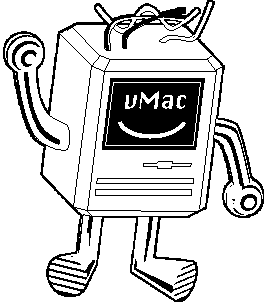
vMac is a free and open-source Macintosh Plus emulator which is able to run versions of System 1.1 to 7.5.5. It is available for Windows, DOS, OS/2, Mac OS, NeXTSTEP, Linux, Unix, and other platforms. Although vMac has been abandoned, Mini vMac, an improved spinoff of vMac, is still actively developed.
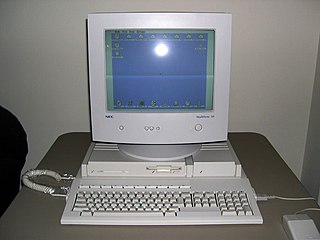
The Atari TT030 is a member of the Atari ST family, released in 1990. It was originally intended to be a high-end Unix workstation, but Atari took two years to release a port of Unix SVR4 for the TT, which prevented the TT from ever being seriously considered in its intended market.

Applied Engineering, headquartered in Carrollton, Texas, was a leading third-party hardware vendor for Apple II computers from the early 1980s until the mid-1990s.
The Apple Network Server (ANS) was a line of PowerPC-based server computers designed, manufactured and sold by Apple Computer, Inc. from February 1996 to April 1997. It was codenamed "Shiner" and originally consisted of two models, the Network Server 500/132 and the Network Server 700/150, which got a companion model, the Network Server 700/200 with a faster CPU in November 1996.
The Macintosh Hard Disk 20 is the first hard drive developed by Apple Computer specifically for use with the Macintosh 512K. Introduced on September 17, 1985, it was part of Apple's solution toward completing the Macintosh Office announced in January 1985. It would be over a year more before Apple would release the file server software AppleShare that would link all of the hardware together. By that time the SCSI interface introduced on the Macintosh Plus in January 1986, would accommodate far faster and more efficient hard drives, rendering the Hard Disk 20 virtually obsolete.

The Dick Smith Super-80 was a Zilog Z80 based kit computer developed as a joint venture between Electronics Australia magazine and Dick Smith Electronics.

The SCC, short for Serial Communication Controller, is a family of serial port driver integrated circuits made by Zilog. The primary members of the family are the Z8030/Z8530, and the Z85233.
















